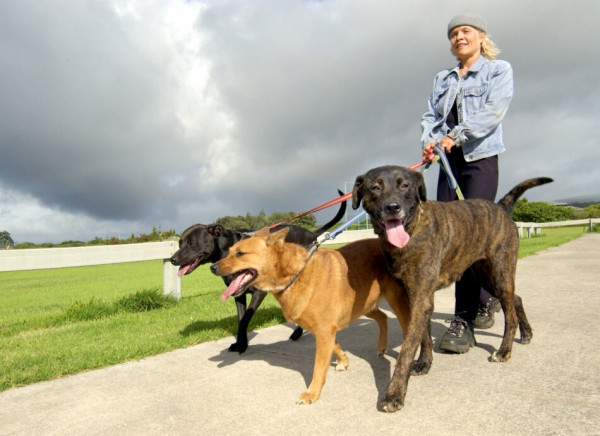Wishing everyone a safe and happy Christmas and New Year – Meri Kirihimete from the Healthify team.
Exercise and the benefits of walking
Key points about the benefits of walking
- Step right up – it’s time to get walking on a regular basis to improve your health and wellbeing. Not only is walking ideal for all ages and fitness levels, it’s free to do.
- Walking is something you can do whenever you want. And you don’t need to spend a lot of money – all you need is a supportive pair of shoes.
- Walking can also contribute to the Ministry of Health’s recommended amount of physical activity per week for adults and children.
- There are lots of reasons to make walking a regular part of your everyday life.


Image credit: Healthify He Puna Waiora
Making walking part of your regular routine helps reduce the risk of:
It also improves your:
- heart rate and circulation
- muscle strength
- bone strength, which decreases your risk of osteoporosis
- balance, which reduces the risk and severity of falls
- use of energy, which helps you maintain a healthy weight
- overall health and wellbeing
- self-esteem
- stress levels.
This list shows the effect of physical activity(external link) on the prevention of different health conditions and reduction of symptoms.
Walking at a brisk pace for 10 minutes or more brings more health benefits. You can warm up and cool down by walking slowly at the beginning and end of your walk.
Obviously, you can walk alone or you can arrange to walk with friends or whānau. You can also search online for a walking group to join.
Tip: If you arrange to meet a friend at a specific time and place, or set a walking date with a whānau member or partner, it can give you the motivation to ‘show up’. Having a companion to chat to while you walk can make the steps fly by.
Try walking different routes to keep it interesting – you never know what you’ll discover when you’re out and about.
Video: Wendy Suzuki: The brain-changing benefits of exercise | TED
Watch this video on the brain changing benefits of exercise. It may take a few moments to load.
(Ted, US, 2018)
You don’t need to spend a lot of money to do it, unlike joining a gym. All you need is a supportive pair of shoes (you can buy new or pick them up more cheaply on Trade Me or at a sale) and you’re ready to go.
Make sure you also wear loose, comfortable clothing, slap on some sunscreen and sunglasses, and drink lots of water. If you have headphones, try listening to music or a podcast as you go. Remember to keep an eye out for traffic once you get your headphones in!
Choose a time that fits into your lifestyle and make it part of your regular routine, eg, if you’re an early bird make your walking shoes the first ones you put on each day. Or, if you’d rather walk during your lunch break, pack your shoes into your work bag the night before. When you make a plan, you’re more likely to do the activity.
Walking after eating or after a meal seems to have some unique and positive health benefits, especially for:
- your digestion
- your blood glucose levels
- your heart health
- your weight
- your sleep.
Improved digestion
Gentle movement like walking can get your digestive system moving, helping food move more quickly through your stomach and intestines.
Improved blood glucose management
Post-meal exercise has been shown to be particularly helpful for people with type 1 or 2 diabetes, since these conditions make it harder for your body to manage blood glucose. However, nearly everyone can benefit from the blood-glucose-lowering effects of light walking after each meal.
Improved heart health through lowering blood pressure and LDL (bad) cholesterol
Getting your body moving regularly is doing your heart and blood vessels a big favour.
Blood pressure
Exercise helps your heart pump more efficiently. This reduces the pressure on your artery walls, lowering your blood pressure and making it easier for your heart to work.
LDL cholesterol
This is the "bad" cholesterol that can build up and clog your arteries, increasing your risk of heart problems. Exercise helps your body clear out this LDL cholesterol, making way for more "good" HDL cholesterol, which helps protect your arteries.
Stroke and heart attack
By lowering blood pressure and cholesterol, exercise reduces the risk of these 2 serious health threats. It also strengthens your heart muscle and improves blood flow, making it less likely for clots to form and block arteries.
It might help with weight management
Walking after meals might make it a little easier to maintain a calorie deficit. This means you're burning off more calories than you're eating.
When is the best time to walk and for how long?
Research suggests that walking for about 10 minutes after meals (preferably 3 times a day) can unlock benefits for your health. Also, short strolls might be easier to fit into your daily routine.
While walking after all your meals might be a bit hard to achieve, taking a walk after dinner is a good place to start. As a bonus, being outdoors means you can enjoy the sights and sounds of your surroundings, breathe in fresh air and say hello to other walkers. Your body and mind will thank you!
You can also incorporate more walking into your day by doing these things:
- Walking to the shops instead of using the car – whenever your destination is less than 1 km away, walk.
- Parking the car further away – it might make it easier to find a parking space as well!
- Taking the stairs instead of the lift.
- Go for a walk while having a meeting with a colleague.
- Walk with a friend, you can still stop and have coffee along the way.
- Getting off the bus a stop earlier than normal.
- Joining a walking school bus.
- Walking your dog (or your neighbour's) before or after work.
- Play with your tamariki, that way they get some exercise too.

Image credit: Canva
There are thinks you can do even if going for a walk is difficult for you:
- Do some stretching and flexing exercises while you are sitting down, eg, while you're watching TV.
- Stand up every time you can eg, while you're talking on the phone or during the ad breaks. Sitting for long periods is not good for your health. Read more about how to stand up more at work.
Start off slowly
If you’re starting out, walk slowly and just for a short distance (even if it’s just around the block) then gradually build it up. You can make it more challenging over time by increasing the distance you walk, the intensity (eg, up hills) and the number of times you do it each week.
Change it up
To avoid getting bored, try taking a different route around your neighbourhood or walking in different places such as the beach, a park or on a walking track. It’s cool to know you can walk round your local community or head to a beach or park or wherever takes your fancy.
Don't let the weather put you off!
Walking is one of the easiest activities to do all year round. With a warm, rainproof coat (one that keeps you visible) and sturdy shoes, you can still reap the benefits of fresh air and witness the changing seasons. If you're feeling cold, physical activity increases your blood flow and helps you to feel warmer – plus there's the promise of a warming hot drink at the end of your walk.
Think about your safety
When you go out for a walk, make sure you stay in a safe, well-lit area. Walking with a friend or whānau member can also make you feel safer as you’re not alone. If you are walking beside a busy road or early morning or evening it might pay to wear some high visibility clothing or something reflective. You might see cars coming, but can they see you? Clip on LED reflective badges for hats, waistbands and shoes are available, and you can get reflective tape to add to shoes or clothing, so it doesn't have to cost a lot to make yourself more visible.
Be patient
You may not notice any benefits straight away from becoming a regular walker, but don’t give up! It can take up to 6 weeks to feel the health benefits. Just know you are doing your body (and mind) a world of good.
Aotearoa New Zealand is full of great places to walk – both short and long walks. Visit your local council website for ideas on where to walk in your area.
Also, check out Green Prescription, a free health and wellness support service to help you and your whānau improve health and wellbeing. The service includes support for getting more active.
Please visit a healthcare provider if you have any questions or concerns about increasing your exercise levels or starting a new fitness programme.
Te Hikuwai resources for wellbeing – physical activity(external link) Te Pou, NZ
References
- How much activity is recommended?(external link) Health New Zealand | Te Whatu Ora
- Walking after eating(external link) Healthline, US, 2020
Credits: Healthify editorial team. Healthify is brought to you by Health Navigator Charitable Trust.
Page last updated:





